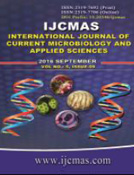


 National Academy of Agricultural Sciences (NAAS)
National Academy of Agricultural Sciences (NAAS)

|
PRINT ISSN : 2319-7692
Online ISSN : 2319-7706 Issues : 12 per year Publisher : Excellent Publishers Email : editorijcmas@gmail.com / submit@ijcmas.com Editor-in-chief: Dr.M.Prakash Index Copernicus ICV 2018: 95.39 NAAS RATING 2020: 5.38 |
Gout is an ataxia evident as a continuum of medical and pathologic portions developed as an establishment when the body has surplus amounts of uric acid, appearing bit by bit by hyperuricemia. This is often depicted by serum urate levels greater than either 6.8 or 7.0 mg/dl. Gout can additionally show up as perpetual joint irritation of 1 or more joints. Gout is typical provocative joint exacerbation connected with essential co-morbidities including hypertension, renal impedance, cardiovascular ailment, weight and Type 2 diabetes. Age, sex, genetic and race-related risks, diet (especially purine rich substances) and a number of pharmaceuticals (thiazide, loop diuretics, ACE inhibitors, and beta blockers) have been found as hazardous variables for improvement of Gout. Gout occurs more in men than ladies and rarely happens in premenopausal Women. Uricostatic drugs (Xanthine oxidase inhibitors) are extensively and most commonly used for the treatment of chronic gout. This study is planned to look at the adequacy of two uric acid chopping down medications (Febuxostat and Allopurinol) for giving symptomatic pain relief and overhauling the utilitarian condition of the patients. Administration of Febuxostat and Allopurinol in Gout patients has emerged to be clinically effective in lowering down the uric acid levels as well as providing symbolic suitable deprivation of pain. In the perspective of undeniable statistical information, we consider that febuxostat should serve as primary choice of drug if early essential and considerable symptomatic improvements are taken into consideration.
 |
 |
 |
 |
 |